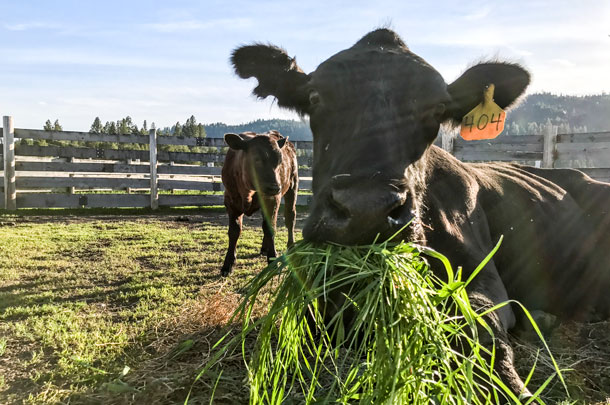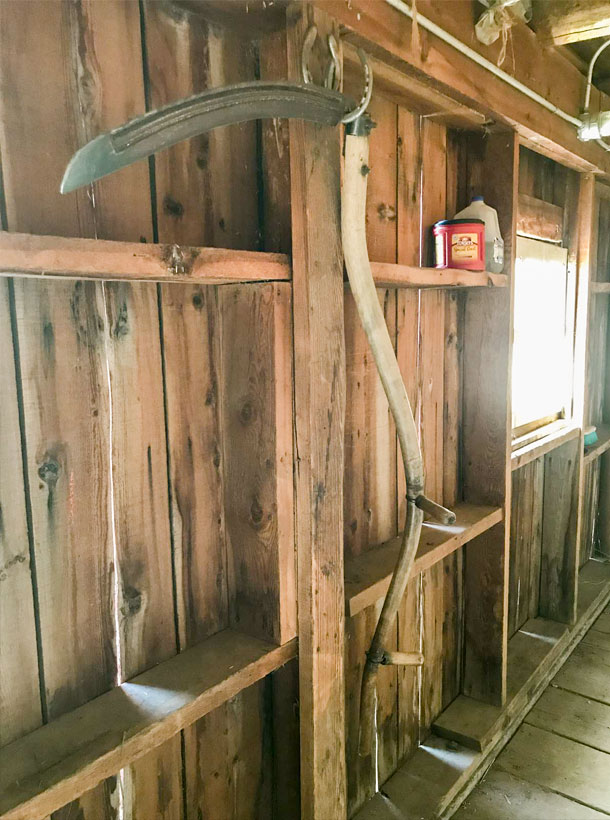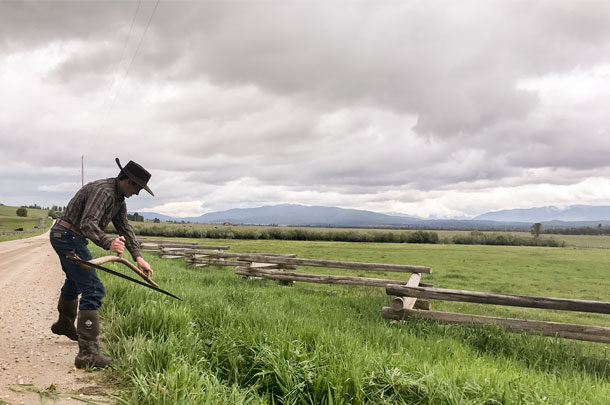Earlier this summer, a scrape with barbed wire left one of our mother cows with a gaping wound on her fetlock. She was corral-bound for the healing process.
In the initial days after the injury, she had a hard time getting up to drink. Her urine took on a Gatorade-like color – unnervingly yellow. Unless we shoved a mobile water trough under her nose, she was reluctant to drink.
My father-in-law suggested we feed her fresh-cut grass to help keep her hydrated.
That’s doable, we thought.
Some of the lushest grass near the corrals is along the roadside where cows don’t regularly graze.
At first we tried harvesting with a weed-whacker. Tall, wet grass kept getting tangled in the head, and what grass we did harvest was shot in all directions, making the collection process scattered at best.
Next we tried using scissors. I would grab a bunch of grass and saw through it, accumulating pitiful handfuls of grass into feed sacks until I’d amassed 20 pounds or so. (I tried my utmost not to let our neighbors see me cut grass with scissors. Super uncool.)
Again, not the most efficient.
Our luck changed when a century-old scythe turned up in the barn.

It sounds moronic, but my husband and I had never seen a scythe, much less used one. Fortunately, we ranch alongside many (many) old people who showed us how to use this ancient object.
The more we used it, the more it was clear that the scythe is an innovation whose design is timeless. It was clearly the perfect tool for the job.
These days, you mostly see scythes (rhymes with “writhes”) as the cheap plastic versions of the real deal alongside Grim Reaper costumes every Halloween. But use of the scythe is alive and well, especially in Asia and Eastern European countries where mechanical harvesting equipment is cost-prohibitive for some farmers. The centuries-old agricultural tool even has a die-hard following in first-world countries like the U.S., where websites like www.scythesupply.com tout the benefits of this tried-and-true (and fuel-free) harvesting method.
My husband would typically do the scything for us. He’d walk at a slow pace, methodically swinging the scythe across thigh-high grass. Harvested grass littered his wake in a neat strip.
I followed with a pitchfork, raking grass into small piles. I delivered several fork-loads to our ailing mother cow, and she eagerly ate it up.
We felt like zookeepers feeding an animal this way, but fresh grass made for a happy cow.

This story doesn’t have a happy ending. Just as the cow started getting up to eat and drink on her own – seemingly on the mend – we came down to the corral one evening to find her dead as a doornail, as cows are sometimes apt to be when you think they’re doing fine.
But the scythe lives on. It now hangs on its own special hook in the barn, sharp as a scalpel, ready to cut grass where no mower can easily go the next time an animal is in need. ![]()
Monica Gokey is a freelancer and livestock producer based in Idaho.
PHOTO 1: Rancher Ty Bequette uses the scythe to cut some fresh grass along the side of the road in Idaho's west central mountains.
PHOTO 2: You might call “green grass beard” the mark of a happy animal. Feeding this injured cow 20 to 30 pounds of fresh grass daily helped keep her hydrated while she was confined to the corrals to let a leg injury heal.
PHOTO 3: In many parts of the world, the scythe has been the tool of choice for grass harvesting for hundreds of years. Photos by Monica Gokey.











